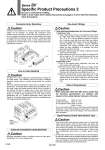
1-p0527-0653-sv1000_en 123 / 128
10秒後にBOOKのページに移動します
One-touch Fittings D D D D S S Connector Entry Directions Caution Caution Other Tubing Brands Caution Back Pressure Check Valve Built-in Type Caution How to Order Manifold Caution Substrate Assemblies inside Manifolds Caution Wiring specifications symbol Lever Lever Connector entry directions for D-sub connectors and flat ribbon cables can be changed. To change the connector’s entry direction, press the levers on both sides of the connector, take it off, and change the direction as shown in the drawing. Since lead wire assemblies are attached to the connector, excessive pulling or twisting can cause broken wires or other trouble. Also, take precautions so that lead wires are not caught and pinched when installing the connector. The letter “S” or “D” is indicated on manifold blocks for series SV as shown below. This indication refers to the type of substrate assembly (single wiring or double wiring) inside the manifold blocks. When the manifold specification sheet does not include a wiring specification, all stations will be double wiring specification (D). In this case, single and double solenoid valves can be mounted in any position, but when a single valve is used, there will be an unused control signal. To avoid this, indicate positions of manifold blocks for single wiring specification (S) and double wiring specification (D) on a manifold specification sheet. (Note that double, 3 or 4 position valves cannot be used for manifolds blocks with single wiring specification (S).) Substrate assemblies inside of manifolds cannot be taken apart. Attempting to do so may damage parts. 1. Valves with built-in back pressure check valve is to protect the back pressure inside a valve. For this reason, use caution the valves with external pilot specification cannot be pressurized from exhaust port [3/5(E)]. As compared with the types which do not integrate the back pressure check valve, C value of the flow characteristics goes down. For details, please contact SMC. 2. Do not switch valves when A or B port is open to the atmosphere, or while the actuators and air operated equipment are in operation. The back pressure prevention seal may be peeled off, which may cause air leakage or malfunctions. Use caution especially when performing a trial operation or maintenance work. 1. When using tube other than SMC brand, confirm that the following specifications are satisfied with respect to the outside diameter tolerance of the tube. 1) Nylon tubing within ±0.1 mm 2) Soft nylon tubing within ±0.1 mm 3) Polyurethane tubing within +0.15 mm within .0.2 mm Do not use tubing which does not meet these outside diameter tolerances. It may not be possible to connect them, or they may cause other trouble, such as air leakage or the tube pulling out after connection. 1. Tube attachment/detachment for One-touch fittings 1) Attaching of tube (1) Take a tube having no flaws on its periphery and cut it off at a right angle. When cutting the tube, use tube cutters TK-1, 2 or 3. Do not use pinchers, nippers or scissors, etc. If cutting is done with tools other than tube cutters, there is the danger that the tube may be cut diagonally or become flattened, etc., making a secure installation impossible, and causing problems such as the tube pulling out after installation or air leakage. Also allow some extra length in the tube. (2) Grasp the tube and push it in slowly, inserting it securely all the way into the fitting. (3) After inserting the tube, pull on it lightly to confirm that it will not come out. If it is not installed securely all the way into the fitting, this can cause problems such as air leakage or the tube pulling out. 2) Detaching of tube (1) Push in the release button sufficiently, and push the collar evenly at the same time. (2) Pull out the tube while holding down the release button so that it does not come out. If the release button is not pressed down sufficiently, there will be increased bite on the tube and it will become more difficult to pull it out. (3) When the removed tube is to be used again, cut off the portion which has been chewed before reusing it. If the chewed portion of the tube is used as is, this can cause trouble such as air leakage or difficulty in removing the tube. Series SV Specific Product Precautions 2 Be sure to read before handling. Refer to front matter 53 for Safety Instructions and pages 3 to 8 for 3/4/5 Port Solenoid Valve Precautions. A 648